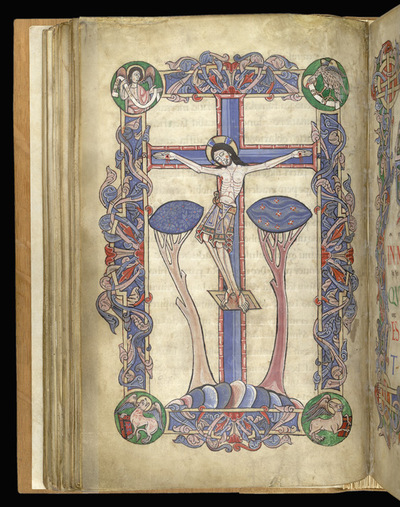Javascript must be enabled to continue!
Crucifixion, The Arundel Psalter f.52v
View through Europeana Collections
Probably made at Winchester, although it is not
certain by or for which religious house there, the Arundel Psalter
seems to have been a personal prayerbook. Throughout the middle
ages, the Psalter was used for church services and as a personal
prayerbook. Individualistic choices of saints for its calendar as
well as Old English glosses on the Latin text suggest this one was
made for private prayer. The Arundel Psalter's decoration was
created in two phases, about mid-century and last quarter of the
century. This Crucifixion belongs to the later phase. It resembles
later 11th-century Norman and northern French manuscript
illuminations in its style and also in the symbolism incorporated
into it. The two trees on either side of the cross represent the
two trees of paradise, the tree of knowledge of good and evil and
the tree of life, referring to the fall of mankind from which the
Crucifixion was supposed to attain salvation. Time is expanded to
future as well as past with the inclusion of the symbols of the
four evangelists (man, lion, ox, eagle), associated both with the
conversion of the world to Christianity and the end of the world
because they appear in the Book of Revelation.
Title: Crucifixion, The Arundel Psalter f.52v
Description:
Probably made at Winchester, although it is not
certain by or for which religious house there, the Arundel Psalter
seems to have been a personal prayerbook.
Throughout the middle
ages, the Psalter was used for church services and as a personal
prayerbook.
Individualistic choices of saints for its calendar as
well as Old English glosses on the Latin text suggest this one was
made for private prayer.
The Arundel Psalter's decoration was
created in two phases, about mid-century and last quarter of the
century.
This Crucifixion belongs to the later phase.
It resembles
later 11th-century Norman and northern French manuscript
illuminations in its style and also in the symbolism incorporated
into it.
The two trees on either side of the cross represent the
two trees of paradise, the tree of knowledge of good and evil and
the tree of life, referring to the fall of mankind from which the
Crucifixion was supposed to attain salvation.
Time is expanded to
future as well as past with the inclusion of the symbols of the
four evangelists (man, lion, ox, eagle), associated both with the
conversion of the world to Christianity and the end of the world
because they appear in the Book of Revelation.
Related Results
Flight into Egypt, and Massacre of the Innocents, in The
Winchester Psalter
Flight into Egypt, and Massacre of the Innocents, in The
Winchester Psalter
Traditionally called the 'St Swithun Psalter'
because it contains a prayer to the saint, this psalter's origins
can be placed at Winchester, probably at the Cathedral Priory,
which...
October, in the Huth Psalter
October, in the Huth Psalter
Named for its donor, the Huth Psalter reveals its
origin by listing in its calendar of feasts and litany Saints Hugh,
Wilfrid, and John of Beverly?all associated with Lincoln or Yo...
Psalter of Saint Louis - folio3v - Ark of Noah
Psalter of Saint Louis - folio3v - Ark of Noah
This manuscript was produced in the mid thirteenth century for St. Louis. It has 78 full-page miniatures depicting scenes of the first books of the Old Testament. The scenes are al...
Holy Bishopric of Morphou: Mural painting of Crucifixion, The prophets Micah and Moses, The way of the cross, Church of the Holy Cross of Ayiasmati (6-6, 60,61,62,63,64)
Holy Bishopric of Morphou: Mural painting of Crucifixion, The prophets Micah and Moses, The way of the cross, Church of the Holy Cross of Ayiasmati (6-6, 60,61,62,63,64)
Mural painting of the Crucifixion in the west gable. Above the Crucifixion are the Ancient of Days and the Holy Spirit, Christ is flanked by two groups: the grieving Virgin Mary, b...
Half Baiocco Coin
Half Baiocco Coin
Obverse: papal coat of arms with crossed keys; reverse: doric pillars with triangular pediment....
Five Centavo Coin
Five Centavo Coin
Obverse: female head in profile left, wearing fillet; reverse: numeral 5 with branch on either side...




